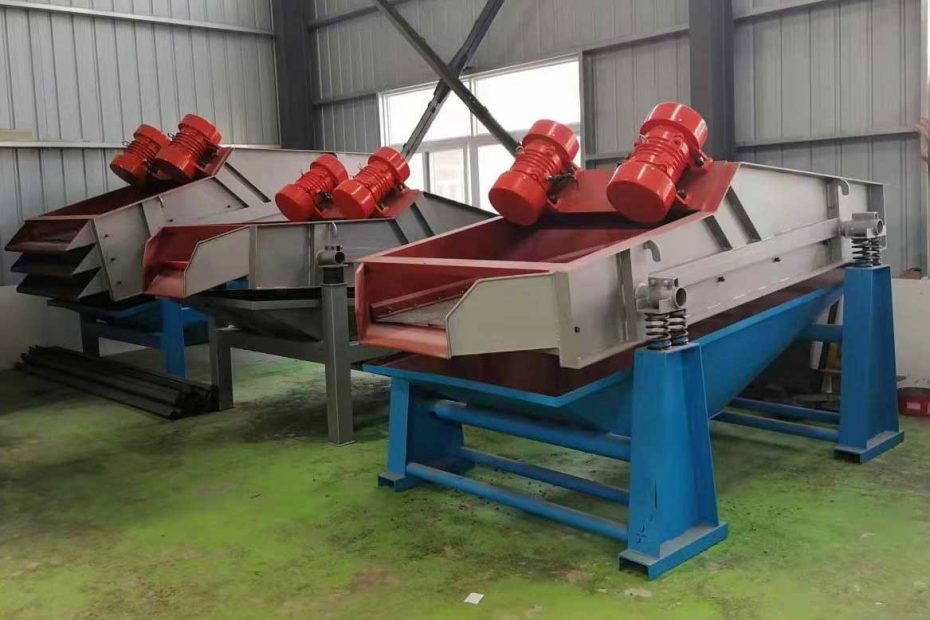A mainstay in coal prep, magnetite recovery, and dewatering, the high-performance Horizontal Vibrating Screen delivers rock-solid dependability. It’s ideal for environments with high production volume but limited space and is available in single, double, and triple decks. Read More: Guide to the Best Vibrating Screen in 2022
Inclined Vibrating Screens
Inclined screens are vibrated by a single, two-bearing, unbalanced rotor mounted concentrically or eccentrically with respect to the centroidal axis of the screen. Overhead-mounted rotors, designated “OHV”, generate a slightly rocking motion. The forward-inclined ellipse at the feed end accelerates incoming material to promote initial screening while the slightly backward-inclined ellipse at the discharge retards the oversize travel rate to help in the final removal of near-size particles.
Concentrically-mounted rotors generate a uniform circular motion over the length of the screen, from feed to discharge, moving oversize material smoothly at a uniform rate. Inclined screens with concentric rotor mountings, designated “CV”, are less susceptible to blinding in coarse screening of acicular or “spikey” particle shapes than units with overhead mountings.
Horizontal Vibrating Screen
Image Source: Horizontal Screens
Vibrating Screens are historically available in two configurations: horizontal or inclined. The Horizontal Screen, as the name states, falls under a “horizontal” screen configuration, is known to operate well at a flat, horizontal area. However, it can still be adjusted to about 10 degrees in any direction.
After primary crushing, a material usually moves to a screening stage where it is sized and separated ahead of further crushing or — in some cases — final stockpiling. Horizontal screens operate at a relatively flat angle usually less than 10°. A series of shafts produce a vibrating effect, which moves the material down the length of the screen. Larger material stays on the top deck while smaller rocks and stones fall through up to four layers of uniquely sized screen media. The result is segregation by screen opening size.
Horizontal screens have around two or three shafts that can be found within the box’s centre of gravity. To effectively provide an oval or linear motion to the horizontal screens, they have been designed and integrated with timing gears and counterweights. They also utilise out-of-balance motors or geared exciters for their linear motion. As these screens operate, they can provide high g-forces to effectively vibrate and move the material down.
Horizontal screens are typically used in portable or mobile equipment, where clearance is an issue, or in applications requiring the most accurate sizing of materials.
Horizontal vibrating screens are available in the same sizes as the equivalent two-bearing inclined models. A pair of gear-coupled, parallel-shaft unbalanced rotors in an enclosed full-width vibrator module applies the straight-line inertia force that generates the reciprocating motion of the screen box.
Features
- Rugged Sideplates of steel reinforced with vertical and horizontal stiffeners.
- Massive body stiffeners reduce body flexing.
- Heavy-duty deck support frame assures strength and reliability without adding excessive weight.
Horizontal vs Inclined Vibrating Screen: Six Differences
- Unlike horizontal screens, inclined screens cannot exert and produce the same high g-forces.
- Since inclined screens only rely on one or two shafts, their expected initial capital expenditure is known to be lower than their counterparts. Additionally, they do not require robust frames and high horsepower motors. And while they are not as efficient as horizontal screens, they are still utilized in stationary plants at any processing phase.
- Unlike horizontal screens, which require high amounts of energy to move material, Inclined Vibrating Screens to deliver at lower costs per ton than horizontals.
- Inclined Vibrating Screens generally accept a continuous feed of material well. They require more headroom than horizontal screens and are usually found in stationary applications where clearance is not an issue.
- The enclosed full-width vibrator module is mounted so that its line of action passes through the center of gravity of the screen box, which moves in a straight-line, reciprocating pitching motion that conveys as it screens. This contrasts with the circular motion of the inclined screen, which depends on its downward slope to move the retained material over the screen.
- The vertical components of the vibrating motion expand the oversize material bed to create extra voidage through which the undersize rapidly settles and finds its way to the screen openings. To control its tendency to produce a “landslide” effect, the inclined screen is limited to lower maximum amplitudes than the horizontal. The greater amplitude required to propel the retained material over a horizontal surface improves stratification, and because the material can’t roll or slide on the level surface, the horizontal vibrating screen is generally considered to be more efficient than the inclined.
When it comes to overall efficiency, horizontal screens are known to be better than inclined screens since they can retain the materials on the screen longer due to their slower travel rate. This mentioned rate allows horizontal screens to thoroughly screen the materials and let them fall through the screen. Portable plants and areas can easily maximize these screens due to their low profile. Most of the time, horizontal screens are intended to be the tertiary or finishing screens. They are also used for dewatering purposes.
Horizontal vibrating screens are mainly used in the chemical industry and mining industries too.
Works Cited: high-frequency vibrating screens wikipedia Overstrom High-Speed Vibrating Screens
